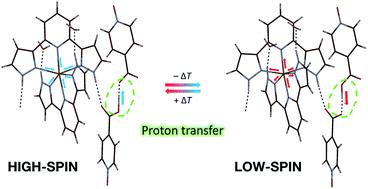当前位置:
X-MOL 学术
›
Chem. Sci.
›
论文详情
Our official English website, www.x-mol.net, welcomes your feedback! (Note: you will need to create a separate account there.)
Interplay between spin crossover and proton migration along short strong hydrogen bonds
Chemical Science ( IF 8.4 ) Pub Date : 2020-11-16 , DOI: 10.1039/d0sc04918b Verónica Jornet-Mollá 1 , Carlos Giménez-Saiz 1 , Laura Cañadillas-Delgado 2 , Dmitry S Yufit 3 , Judith A K Howard 3 , Francisco M Romero 1
Chemical Science ( IF 8.4 ) Pub Date : 2020-11-16 , DOI: 10.1039/d0sc04918b Verónica Jornet-Mollá 1 , Carlos Giménez-Saiz 1 , Laura Cañadillas-Delgado 2 , Dmitry S Yufit 3 , Judith A K Howard 3 , Francisco M Romero 1
Affiliation

|
The iron(II) salt [Fe(bpp)2](isonicNO)2·HisonicNO·5H2O (1) (bpp = 2,6-bis(pyrazol-3-yl)pyridine; isonicNO = isonicotinate N-oxide anion) undergoes a partial spin crossover (SCO) with symmetry breaking at T1 = 167 K to a mixed-spin phase (50% high-spin (HS), 50% low-spin (LS)) that is metastable below T2 = 116 K. Annealing the compound at lower temperatures results in a 100% LS phase that differs from the initial HS phase in the formation of a hydrogen bond (HB) between two water molecules (O4W and O5W) of crystallisation. Neutron crystallography experiments have also evidenced a proton displacement inside a short strong hydrogen bond (SSHB) between two isonicNO anions. Both phenomena can also be detected in the mixed-spin phase. 1 undergoes a light-induced excited-state spin trapping (LIESST) of the 100% HS phase, with breaking of the O4W⋯O5W HB and the onset of proton static disorder in the SSHB, indicating the presence of a light-induced activation energy barrier for proton motion. This excited state shows a stepped relaxation at T1(LIESST) = 68 K and T2(LIESST) = 76 K. Photocrystallography measurements after the first relaxation step reveal a single Fe site with an intermediate geometry, resulting from the random distribution of the HS and LS sites throughout the lattice.
中文翻译:

自旋交叉和质子沿短强氢键迁移之间的相互作用
铁( II )盐 [Fe(bpp) 2 ](isonicNO) 2 ·HisonicNO·5H 2 O ( 1 ) (bpp = 2,6-双(吡唑-3-基)吡啶;isonicNO = 异烟酸N-氧化物阴离子) 在T 1 = 167 K处经历对称性破缺的部分自旋交叉 (SCO),进入混合自旋相(50% 高自旋 (HS)、50% 低自旋 (LS)),该相在T 2 =以下是亚稳态的116 K。在较低温度下对化合物进行退火会产生 100% LS 相,该相与初始 HS 相不同,在两个结晶水分子(O4W 和 O5W)之间形成氢键 (HB)。中子晶体学实验还证明了两个等离子NO阴离子之间的短强氢键(SSHB)内的质子位移。这两种现象也可以在混合自旋相中检测到。1经历了100% HS相的光致激发态自旋捕获(LIESST),伴随着O4W⋯O5W HB的断裂以及SSHB中质子静态无序的开始,表明存在光致活化能质子运动的势垒。这种激发态在T 1 (LIESST) = 68 K 和T 2 (LIESST) = 76 K 处显示出阶梯式弛豫。第一个弛豫步骤后的光晶体学测量揭示了具有中间几何形状的单个 Fe 位点,这是由 Fe 的随机分布造成的。 HS 和 LS 位点遍布整个晶格。
更新日期:2020-11-23
中文翻译:

自旋交叉和质子沿短强氢键迁移之间的相互作用
铁( II )盐 [Fe(bpp) 2 ](isonicNO) 2 ·HisonicNO·5H 2 O ( 1 ) (bpp = 2,6-双(吡唑-3-基)吡啶;isonicNO = 异烟酸N-氧化物阴离子) 在T 1 = 167 K处经历对称性破缺的部分自旋交叉 (SCO),进入混合自旋相(50% 高自旋 (HS)、50% 低自旋 (LS)),该相在T 2 =以下是亚稳态的116 K。在较低温度下对化合物进行退火会产生 100% LS 相,该相与初始 HS 相不同,在两个结晶水分子(O4W 和 O5W)之间形成氢键 (HB)。中子晶体学实验还证明了两个等离子NO阴离子之间的短强氢键(SSHB)内的质子位移。这两种现象也可以在混合自旋相中检测到。1经历了100% HS相的光致激发态自旋捕获(LIESST),伴随着O4W⋯O5W HB的断裂以及SSHB中质子静态无序的开始,表明存在光致活化能质子运动的势垒。这种激发态在T 1 (LIESST) = 68 K 和T 2 (LIESST) = 76 K 处显示出阶梯式弛豫。第一个弛豫步骤后的光晶体学测量揭示了具有中间几何形状的单个 Fe 位点,这是由 Fe 的随机分布造成的。 HS 和 LS 位点遍布整个晶格。



























 京公网安备 11010802027423号
京公网安备 11010802027423号